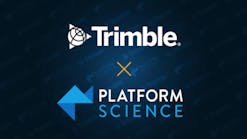Latest from Technology
Mack enhances connected-vehicle capabilities
BeyondTrucks expands integration hub
Base boosts worksite communications
Daimler Trucks North America’s (DTNA) SuperTruck program has achieved 115% freight efficiency improvement--surpassing the Department of Energy (DOE) program’s goal of 50% improvement and exhibiting the best results of all reporting OEMs. Daimler’s SuperTruck was unveiled at the 2015 Mid-America Trucking Show.
To validate the lofty targets set by the DOE, DTNA engineers conducted a series of tests. To measure freight efficiency, DTNA ran vehicle testing on highway routes in Oregon and Texas, one city route in Portland OR, and anti-idle testing in both a cold chamber and hot chamber. These tests resulted in a combined 115% freight efficiency improvement over a 2009 baseline truck.
Testing was also conducted at the DTNA Detroit engineering facility to demonstrate engine efficiency by achieving 50.2% engine brake thermal efficiency.
The final SuperTruck demonstrator ran a five-day, 312-mile round trip route on Texas Interstate Highway 35 between San Antonio and Dallas, at a weight of 65,000 pounds gross vehicle weight at a speed of 65 mph, where it achieved an average result of 12.2 mpg.
“We are thrilled with the positive results, and are honored to have been part of the program,” said Derek Rotz, principal investigator for SuperTruck, Daimler Trucks North America. “It is our expectation that we will continue to review and refine what we’ve learned and achieved over the course of the SuperTruck initiative, and use that knowledge to bolster our leadership in fuel efficiency.”
Several commercially viable technologies developed in conjunction with the SuperTruck program have been introduced in DTNA production vehicles, including 6x2 optimization and the aerodynamic components found on the Freightliner Cascadia Evolution and the integrated Detroit Powertrain.
Strategies such as downspeeding with a custom engine rating and using the predictive capabilities of Intelligent Powertrain Management (IPM) components such as pre-loaded 3D digital maps to control shifting and eCoast events also increased efficiency and economy.
“By incorporating a mix of available technologies with future innovations, we were able to use the SuperTruck program to take the first steps in seeing what may be technically possible and commercially viable,” said Rotz. “We still have a long road ahead to determine ultimately what will be successful and what will achieve the greatest efficiencies.”
One key initiative was exploring how the tractor and trailer should be designed and optimized as a single system, not separate units. DTNA engineers also examined the impact and opportunities for efficiency gains with tire partners.
Features such as energy-efficient, wide-based, low-rolling resistance single tires and highly engineered aerodynamic surfaces on the trailer also maximized efficiency.
“We took a clean-sheet approach and looked beyond just the vehicle and engine,” noted Rotz. “We examined and analyzed and tested every single angle on the truck and trailer in our quest to achieve the best results.”
During the development of the SuperTruck, DTNA engineers investigated how high-risk, high-reward technologies used in other industries could be applied to Class 8 vehicles. Electrified auxiliaries, controlled power steering and air systems, active aerodynamics, a long-haul hybrid system, waste heat recovery, and trailer solar panels were some of the items assessed.
“Part of our process included taking a deep dive into different systems to analyze not only what might be possible, but obstacles as well,” said Rotz.
The SuperTruck team discovered that some of these components may not be commercially viable in the near future, due to regulatory or economic barriers.
Sponsored by the US Department of Energy (DOE), the SuperTruck program was a five-year research and development initiative to improve freight efficiency by at least 50%, brake thermal efficiency by 50%, and reduce fuel consumption and greenhouse gas emissions of Class 8 trucks. DTNA and three other major truck OEMs were awarded multi-million dollar grants by the DOE and each matched the DOE funding dollar for dollar.
SuperTruck is supported by DOE under the American Recovery and Reinvestment Act of 2009. DTNA began work on the SuperTruck program in 2010 together with Detroit and other partners, including national labs, universities, and suppliers.
For more information about the SuperTruck program, go to www.freightlinersupertruck.com.










